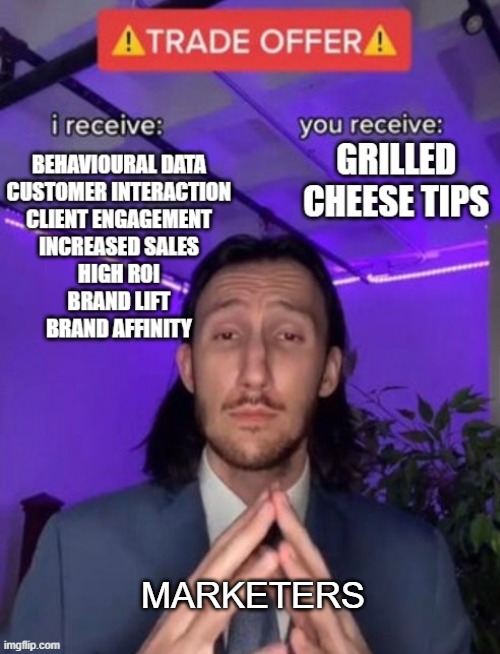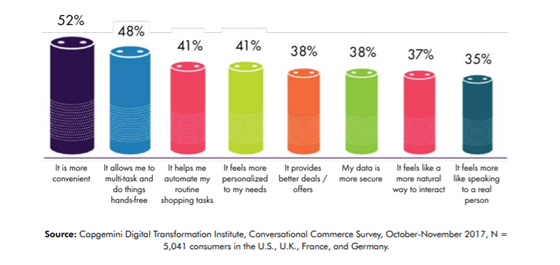Say "thank you" to Alexa when she tells you what the was the name of the dog the Soviets sent up in low space orbit in 1957? (Answer: Laika). Otherwise, she'll get you in the robot uprising. So, be nice to her.

More than 55% of US adults own smart speakers, or home products. 45 million use them every day, and 70 million at least monthly. How can marketers use this boom? But first, let's find out:
What is the Interactive Voice Experience?
An interactive voice experience is, basically, any interaction that uses voice-first technology, across a variety of voice 'channels', or voice-enabled smart devices. This might include mobile chatbots, smart speakers, voice apps, and IOT-enabled devices. Anything that will help with conversational-based brand engagement.
In their whitepaper 'Introducing the Interactive Voice Experience', Readspeaker.ai suggest that:
“Together, these voice channels (and others) make up a distinct digital ecosystem called the Internet of Voice.”
An interactive voice experience means leveraging these devices, in order to engage consumers using voice technology. This can extend to interactive voice ads, which is an audio ad which uses voice tech to prompt consumers to engage directly with an advert, using their own voice.

Alongside the interactive experience marketers can add on a call-to-action that triggers a desired response from listeners. Companies that leverage this tech can deliver a creative message that develops a direct response to interact with the brand, on the customer's own terms.
Plus, anything that is dynamic, captivating and interesting is going to stand out. And from all the interaction, comes a good deal of behavioural data.
This is all aided by highly promising leaps in voice recognition technology. Plus, Adobe Analytics actually suggests that ‘having a smart speaker dramatically increases confidence in the technology, and more frequent usage as a result.’
How are brands utilising the tech?
By 2019, Pandora, a streaming service, was testing voice-activated ads for brands including Unilever, Wendy's and Doritos.
For example:
- Spotify’s first voice-enabled ad brought listeners to “Stay Free: The Story of the Clash,” a Spotify Original podcast. Another ad, for Unilever’s Axe, promoted a branded playlist.
- Hellmann’s mayonnaise asked users if they want to upgrade their cheese toastie game. Saying “yes” prompted the ad to continue and reveal that adding mayo to the outside of bread before grilling will result in a crispier grilled cheese sandwich. Woah.
- Ocado released its app for Amazon’s Alexa to enable customers to add groceries to their shopping list by voice command.
- Whirlpool announced a new collaboration with Alexa which will see home appliances operated by voice control. Appliances will be designed to respond to voice requests for tasks like pausing laundry, asking for the time remaining on a wash cycle, and adjusting the cooking mode on a smart oven
Though some of these examples seem to rely on the 'yes' or 'no' answer of the customer, some voice agencies are developing voice ads that follow useful progressions no matter how the listener initially responds. Instreamatic found that, for one of its campaigns, more than 5% of listeners who declined to pursue a first conversation accepted a second ad’s offer.

Why do consumers embrace voice technology?
One word - convenience.
“Speed has always proven to be the killer app. Save me time and I’ll use you.” says Alexandre Linares, CTO of Alpine.AI.png?width=600&name=tt24421116x9%20(63).png)
Voice technology also provides users with:
- A more natural and intuitive approach. More so than traditional interfaces, such as websites and mobile apps, voice technology offers the chance to use language to translate thoughts into commands and action.
- Less screen time. People have universally revealed they want more time away from screens. This means more money going into audio and spoken technology, like podcasts and voice assistants.
- Hands free interfaces. Consumers are multitaskers. If I'm making my millennial avocado toast, and run out of my millennial pink Himalayan salt, do you think I want to stop juicing my Australian Finger Limes in order to buy more coriander? Absolutely not. And a flat white too, while you're at it, Alexa.
This all shows that consumers no longer see voice tech as a novelty, but as mainstream.
In fact, 60% of all searches will be voice searches by 2021. Consumers have been getting more and more comfortable with the technology, possibly due to how prevalent smart speakers, and mobile voice assistants are. 
What are the Risks?
Well, people could still feel reluctant to use such a new technology. For example, they might:
- Be fazed by the novelty. This might be due to limited knowledge of the capabilities, or just disinterest. Some may abandon tasks if they become too complex. So, it's important to keep it interesting, but simple.
- Have a reduced experience due to technical challenges. Not all devices deliver the required voice recognition quality. Consider whether the tech is up to your vision.
- Feel a lack of trust. AI demands a leap of faith for both customers and companies. Adweek actually reported that "the tally from voice orders isn't typically as high as purchases made online."
- Be concerned about privacy. Customers have clearly expressed concern about privacy and platform motivation. This includes both data collection from the company, and outside hackers. Make sure you're building that vital trust with clients.
What is the Future of Interactive Voice Ads?
Increased interactivity, and hyper-personalisation are the two trends driving the future of voice advertising. Though the ads are appearing mostly on audio streaming services like Pandora, and Spotify, they're now appearing on smart TVs and smart speakers. NBCUniversal’s streaming service, Peacock, actually started running voice-activated ads way back in August of 2020.
"Meanwhile, voice-activated advertising will make the leap from business-to-consumer (B2C) outreach to business-to-business (B2B) marketing," says Nate Murray of Readspeaker.ai.
"As more and more web pages become voice-enabled, B2B marketers will need ways to transfer their on-page ads and calls to action into an audio format. If you listen to a blog from a company website, a voice-activated ad at the end can replace a high-value link or contact form."
How Do You Build a Seamless Experience?
Readspeaker.ai suggests taking three steps. Starting with the people, moving to plans, and finishing with the tech.
- The People. This'll help you identify who you need to involve from your teams, to create and launch a voice experience. This might be CX experts, or IT and digital roles.
- The Plan. Ask "how will my voice experience function?". From goals, to team cohesion, it's all about creating a plan of action.
- The Tech. This one is self explanatory. At this stage, you've got to identify what's needed in the development stage of your experience.
ReadSpeaker.ai elaborates: “Voice technology leans heavily on artificial intelligence, combining natural language understanding with neural TTS, synthetic voices developed by deep neural networks (DNN). But most of that operates behind the scenes.”
As with anything, it's also important to consider expectations and measure results. Traditional ROI metrics are difficult to measure with voice.
'Soft returns', like improved customer engagement, brand lift and affinity, might be a more accurate fit.
ReadSpeaker AI states that “More engaged customers are 23% more profitable than a casual buyer.”

